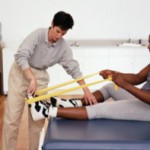 Ergonomics is the science that deals with how a person effectively works in a given environment. There should be a balance between the physical requirements of the job with the physical capacity of the person. Otherwise, this would result in acute and chronic work-related physical injuries that may greatly affect the person’s overall performance.
Ergonomics is the science that deals with how a person effectively works in a given environment. There should be a balance between the physical requirements of the job with the physical capacity of the person. Otherwise, this would result in acute and chronic work-related physical injuries that may greatly affect the person’s overall performance.
Usually, ergonomics is easily connected to office and work place settings. However, it can also apply to children and teenagers who are commonly using desktop computers, laptops, tablets and other mobile computing devices in a school environment.
Work-related musculoskeletal disorders (WMSDs) are avoidable if ergonomic principles are applied. As a physical therapist, we are very aware of proper body mechanics and the use of adaptive equipment. In fact, work analysis and industrial consultation is a specialization in physical therapy that provides work-site evaluations to improve the work quality, productivity and overall health of working individuals. These therapists assess and devise a plan to decrease, if not prevent, WMSDs to injured or prone-to-injury workers.
Honestly, physical therapists are at the core of ergonomics. We have the responsibility to not only preach to our clients, but also to demonstrate the principles effectively. As per OSHA, ergonomics is a clinical safety concern. The physical therapy staff is exposed to common WMSDs from continued lifting and reaching for patients during transfers and treatments. Healthcare facilities usually with low level patients have to establish effective transfer and equipment protocols during employee training. This will prevent employers from losing money in work compensation costs.
According to Workers Compensation Fund, the following are contributing factors to WMSDs:
- Force
- Repetition
- Posture
- Lack of recovery time
- Vibration
- Temperature
- Non-work related issues such as lifestyle, hobbies, employee morale, current health etc.
A careful review of these factors will identify and prevent the prevalence of WMSDs. Upon assessment of these physical stressors, modifications can then be applied and should be practiced on a regular basis.
On OSHA’s website for clinical services, it recognizes the misapplication of ergonomics as a potential health hazard to not only the patient but also the physical therapist. It recommends the following to physical therapists:
- Evaluate the lift. See if there is a need to call for more staff, to use a particular technique, or to use mechanical lift equipment to successfully transfer a patient.
- Assume the “lifting” stance: bent knees, straight back and using arm and leg muscles efficiently.
- Use smooth and steady lifting motions and avoiding twisting while lifting.
In a number of hospitals and skilled nursing facilities around the country, a no-lift policy has been implemented to benefit the clinical workers. Electric lifts, hydraulic lifts, stand-up lifts, bariatric lifts and slings and an assortment of slide boards and sheets are currently available for use. In the world of physical therapy, mechanical lifts for patient transfers are primarily performed by nursing staff due to the lack of active patient participation.
Patient screening prior to a mechanical lift or slide board/sheet transfer might be a necessity in some special patients. A therapist or any healthcare professional should assess if a patient has certain physical conditions that prevent a safe transfer. These may include skin issues, multiple life-saving lines, orthopedic hardware considerations, prosthetic or orthotic restrictions and others.
In sum, ergonomics is key to the overall efficiency of a person, whether it is the patient, client or therapist.
About the Author
Joahnna Almero is a licensed Physical Therapist working as a full-time acute inpatient clinician and developing hospital-based patient care projects. She has a bachelors in Physical Therapy from Velez College and licensed to work in Florida, North Carolina and Texas.







